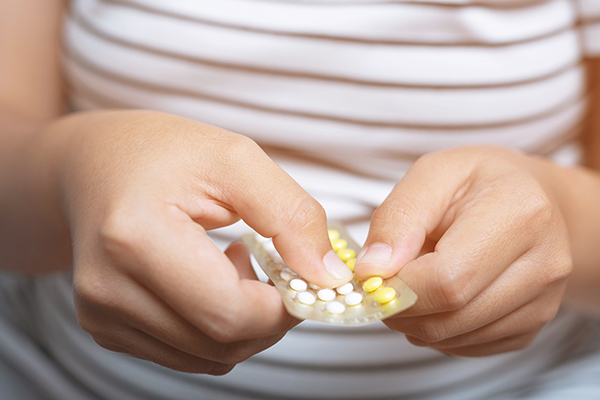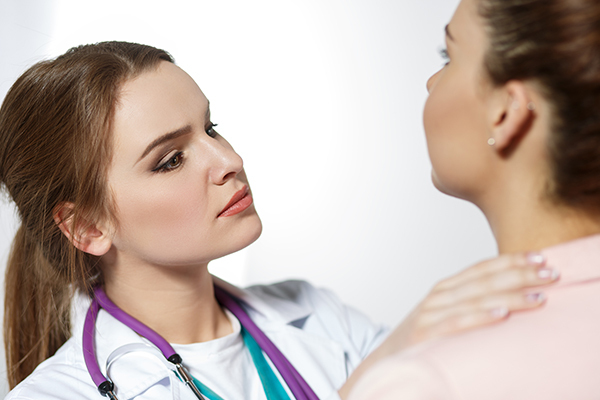In this article:
Most people suffer from acne during their teen years. The body undergoes several changes during puberty – including a major increase in hormone production. These hormones act on the oil glands present in the skin, which indirectly leads to acne. (1)

However, at times, acne can persist into the adult years. This may occur due to any hormonal changes, such as those caused by pregnancy, stress, hormone disorders, and the use of birth control pills. (2)
Causes of Hormonal Acne
Hormonal acne occurs as a result of hormone fluctuations in the body. An imbalance in hormone levels leads to an increase in sebum production by the oil glands. This can lead to clogged pores, minor bacterial infections, and eventually acne. (3)
Certain factors can trigger or aggravate acne, including: (4)
- Pregnancy
- Stress or anxiety
- Birth control medications
- Hormone disorders such as polycystic ovary syndrome (PCOS)
- A family history of acne
- Increased androgen levels in the body (4)
- Menstruation
- Testosterone supplements
- Hyperinsulinemia
Treatment Modalities for Hormonal Acne
Several medical treatments are available for acne.
First-line and alternative treatment options:

Topical medications and oral medicines are usually the first-line treatment for acne.
a. Topical agents
- Topical antibiotics are usually the first treatment prescribed for acne. Examples are dapsone, clindamycin, and nadoxin. (5)(6)
- Adapalene gel (0.1%), tretinoin gel/cream (0.025%), and other topical retinoids are commonly used to treat comedonal acne. (7)
b. Other topical agents
- Benzoyl peroxide contains anti-inflammatory properties and is commonly used for inflammatory acne. (6)
- Azelaic acid is used in topical formulations to reduce hyperpigmentation caused by acne. (8)
- Salicylic acid used in face washes, gels, and serums. (8)
c. Oral medications
Oral antibiotics can be prescribed to cure acne. These include doxycycline, minocycline, and azithromycin.
d. Hormonal agents/anti-androgen drugs
Anti-androgen therapy refers to medication taken by women to counteract the effects of male sex hormones such as testosterone on the skin. Anti-androgens are not suitable for skin problems in men.
Increased androgen levels are a common cause of acne in women. Anti-androgen drugs are prescribed in these cases to inhibit testosterone activity in the body.
Anti-androgen therapy works by:
- Reducing insulin resistance in the body
- Reducing androgen production in the ovaries
- Reducing the production of prolactin in the pituitary glands
- Blocking androgen receptors in the body
- Reducing androgen production in the adrenal glands
- Inhibiting the enzyme 5-alpha reductase that helps increase dihydroxy testosterone levels
Some commonly prescribed anti-androgen medicines are:
1. Spironolactone
Spironolactone is a diuretic that helps flush out excess fluid and slow down testosterone production in the body. It is derived from the hormone aldosterone and can be effective in treating hormonal acne caused by high testosterone levels.
Spironolactone has been known to significantly reduce acne levels in the body within 3–6 months of use. (9)(10)(11)(12)
Caution:
- Spironolactone is a diuretic and may cause increased urination.
- Spironolactone is also not prescribed for men as it decreases testosterone levels in the body.
- Pregnant women should not take this medicine as it can harm the fetus.
- Avoid consuming excess potassium while taking spironolactone.
Side effects:
Spironolactone can cause menstrual irregularities and tenderness or enlargement of breasts.
2. Oral isotretinoin tablets
Oral retinoids are prescribed for severe cases of acne when other treatments are not working. (13) They are usually prescribed in lower doses to be taken with food.
Caution: Oral retinoids cannot be taken during pregnancy as they can lead to birth defects. (13) Stop taking these medicines at least 3 months before planning to conceive.
3. Combined oral contraceptives

Combined oral contraceptives (COCs) are birth control medications that contain synthetic estrogen (ethinyl estradiol) and synthetic progesterone (progestin). COCs contain estrogen that helps reduce androgen levels in the body, which in turn reduces acne.
Research suggests that progestins may not be as effective as estrogen in reducing testosterone levels. Hence, birth control medicines that contain only progestins may not be helpful in curing acne. (6)(14)(15)
A number of different COCs are available today. The US FDA has approved only three of them to be sold in the United States. However, multiple studies have shown that all COCs are effective in treating acne. (16)(17)(18)
Side effects:
COC’s may sometimes lead to ‘thromboembolisms’ – blood clots or obstructions in the blood vessels that can be fatal. Hence, they should not be used by women who are at risk of clotting, such as women suffering from heart diseases, clotting disorders, hypertension, obesity, cancer, or diabetes and those who are pregnant or lactating.
4. Flutamide
Flutamide is an anti-androgen drug used in the treatment of prostate cancer. (19) It blocks androgen receptors to lower testosterone levels in the body. Flutamide is sometimes used to cure hormonal acne. (20)
5. GnRH Agonists
Medicines known as GnRH agonists (such as buserelin, leuprolide, and nafarelin) (21) work by stopping the production of GnRH to lower androgen levels in the body and cure acne. They are only prescribed for women who do not respond to COC treatments.
Side effects:
GnRH agonists are not commonly used in women because they lower estrogen levels, which may lead to unpleasant side effects such as irregular bleeding and osteoporosis. GnRH agonists should not be used while pregnant or lactating.
Clinical Treatment for Hormonal Acne
Surgical treatment options are available for people who do not respond to any of the above treatments.
In-clinic treatments:
1. Chemical peels

Chemical peels are used to carefully peel away the top layers of your skin to stimulate the production of new skin cells. They help get rid of chronic acne, acne scars, and clogged pores. (22)
There are many types of chemical peels, ranging from light peels to deeper treatments.
2. Laser treatments
LASERs (light amplification by stimulated emission of radiation) are single wavelengths of high-intensity light that help treat various skin conditions such as acne, scarring, and wrinkles.
- Pulsed-dye lasers (PDL): Pulsed dye lasers are lasers that use solutions with organic dyes. A high-intensity laser is used to pump this solution to treat acne and redness. (23) It relies on the principle of selective photothermolysis (i.e., concentrating heat on a specific diseased tissue without damaging the surrounding healthy tissues).
- Potassium titanyl phosphate lasers (KTP): Potassium titanyl phosphate lasers use potassium titanyl phosphate to produce a green light with a wavelength of 532 nm. It is a very effective procedure with minimal side effects that can help cure acne and redness. (24)
- Photodynamic therapy (PDT): Photodynamic therapy is a process in which a photosensitive solution is applied to the skin before treating it with a laser device. (25) This helps the laser to penetrate the skin better. PDT therapy is a great way to get rid of acne, acne scars, and cysts.
- Photopneumatic therapy: Photopneumatic therapy involves the use of an intense pulsed light (IPL) laser and a vacuum. It helps unclog your pores and cleanse your skin of excess oil and dirt. (26) It is an FDA-approved treatment and also helps reduce blackheads and whiteheads and treat nodules.
3. LED treatments

Light therapy for acne involves the use of special devices that use red and blue light. It is used to treat inflammation and pimples, reduce oil production, and soothe the skin.
- Blue, red, and blue+red light devices: These devices are called visible light devices as the color of the light emitted can be seen. (27) Visible light only helps cure pimples and does not have any effect on blackheads, whiteheads, acne cysts, or nodules.
- At-home devices: At-home LED devices are an efficient way to treat acne without having to go to a dermatologist. Many types of visible light devices are available nowadays, including Blue, red, and red+blue light devices. However, they are not as effective as the clinical LED devices. (28) Most at-home LED devices need to be used for half an hour for at least one or two months every day to see results, and such results are not guaranteed.
- Infrared light: Infrared light can be used to cure pimples, but it does not have any effect on blackheads, whiteheads, cysts, etc. (27)
- Intralesional corticosteroid injections: Intralesional steroid injections are used to treat cysts and nodular acne. Cortisone injections are administered into the lesion to reduce inflammation immediately. (29) Note that these injections can cause sunken skin or skin lightening in the area where it was administered.
The Science
Hormone fluctuations are a common cause of acne in both sexes. Hormone changes are most commonly noticed during puberty and, thus, many teenagers suffer from acne.
Each of these hormones plays a different role in causing acne:
- Testosterone: Increased testosterone levels can lead to acne in both men and women due to the higher oil production that they cause.
- Androgens (male hormones present in both males and females): Androgen production leads to increased oil levels in the skin. Higher levels of androgens can cause acne in both men and women.
- Estrogens: Estrogen affects the oil glands of your skin to increase oil production. Hence, fluctuations in estrogen levels during your menstrual cycle or pregnancy may lead to cyclic acne.
- Progesterone (hormone present in both males and females): Progesterone may lead to increased levels of sebum production in the skin. However, more research is needed to confirm its role in the sebum glands.
When to See a Doctor

You may need to consult a dermatologist if:
- You are suffering from acne scars or hyperpigmentation.
- Your acne is affecting your self-esteem or confidence.
- Over-the-counter products are not helping.
Final Word
Hormonal acne can be a difficult condition to bear. If you suffer from this problem, consult a dermatologist to get a treatment plan based on your skin type and the severity of your acne.
At times, birth control is prescribed as a treatment. You can discuss the pros and cons of using birth control with your doctor if they feel this is the right treatment for you.

- Was this article helpful?
- YES, THANKS!NOT REALLY


